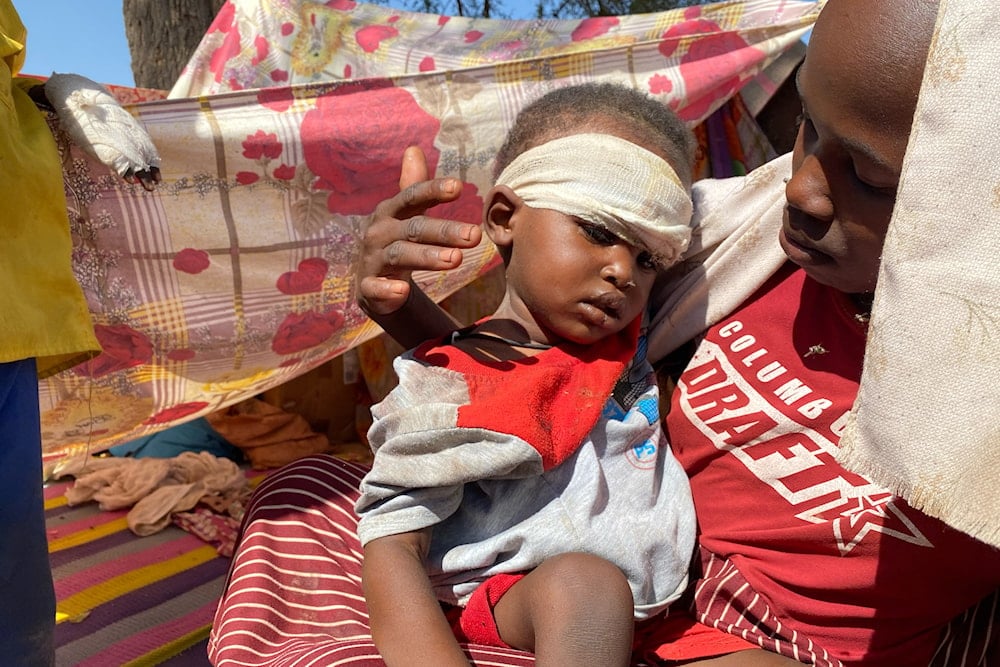Eyewitnesses recount RSF massacres in El Fasher after its fall
Eyewitnesses recount RSF atrocities in El Fasher, from drone strikes to mass killings, while satellite images reveal mass graves and blocked escape routes.
-

A Sudanese child who fled E -Fasher city with family after Sudan's paramilitary forces killed hundreds of people in the western Darfur region, receives treatment at a camp in Tawila, Sudan, Sunday, Nov. 2, 2025 (AP)
Witnesses recounting the initial days of the RSF’s takeover in al-Fashir told Reuters that civilians were gunned down in the streets, struck by drone attacks, and run over by trucks, painting a harrowing picture of the brutal seizure of one of Sudan’s largest cities.
A witness recounted that while he and others were attempting to escape heavy shelling, RSF trucks encircled the group, unleashing machine-gun fire on civilians and running them over with their vehicles.
“Young people, the elderly, and children, they ran them over,” said the witness, who withheld his name out of fear of retaliation while speaking by phone from Tawila, adding that some civilians were also taken away by RSF fighters.
Sixty people massacred in cold-blood
The violence carried on into the second day of the RSF attack, according to another witness named Mubarak, now in al-Dabba, who said that after seizing the army’s base the previous day, RSF fighters began storming homes across residential neighborhoods.
“Fifty or sixty people in a single street... they kill them bang, bang, bang. Then they would go to the next street, and again bang, bang, bang. That’s the massacre I saw in front of me,” Mubarak said, adding that many residents, particularly those who were injured or elderly, remained trapped in the city and were killed inside their homes.
Local resistance fighters, mostly young men carrying arms, took to the streets to confront the offensive as army soldiers and their allies stayed back in bases or pulled out, and “they were the ones who died more,” Mubarak told Reuters.
Anyone who stepped outside was “targeted by the drones and a lot of bullets,” Mubarak said, as residents of al-Fashir have described drones tailing civilians and striking any form of gathering in recent months, while another witness, Abdallah, speaking to Reuters from al-Dabba, recounted seeing fleeing civilians attacked by drones and said he came across about 40 bodies lying in one area of El Fasher.
Satellites reveal the harrowing picture
Satellite images analyzed by Yale’s Humanitarian Research Lab last week revealed objects resembling human remains scattered across several areas of El Fasher, while additional imagery indicated soil disturbances consistent with mass graves and the disappearance of objects alongside the appearance of large vehicles, suggesting the movement of bodies, people, or looted goods, the lab said this week.
The imagery also appeared to show that the RSF had blocked a major exit route leading from the city to the nearby town of Garney. UN human rights chief Volker Türk said on Friday that traumatized civilians remain trapped inside El Fasher, warning, “I fear that the abominable atrocities such as summary executions, rape, and ethnically motivated violence are continuing.”
A day earlier, the RSF announced it had accepted a proposal from the United States and several Arab nations for a humanitarian ceasefire and expressed willingness to engage in talks over a potential halt to fighting, yet on Friday morning, eyewitnesses reported RSF drone strikes on Khartoum and the city of Atbara.
Both the RSF and the Sudanese army have previously agreed to numerous ceasefire initiatives throughout the conflict, which has deepened famine across the country, including in El Fasher, but none have been successfully upheld.
Those who managed to escape El Fasher described perilous journeys marked by brutal RSF searches, the disappearance of men, and kidnappings carried out for ransom.
Umm Jumaa told Reuters she reached al-Dabba with four of her grandchildren but still cannot find her two sons, both army soldiers, or her daughter, adding that before she fled El Fasher, she saw RSF fighters beat civilians to death.
"Those who didn't die, they would say, 'finish them off, finish them off, this one isn't dead, finish him off.'"
RSF massacre El Fasher
The city of El Fasher in North Darfur fell to the paramilitary Rapid Support Forces (RSF) on October 26, 2025, after an 18-month siege and the collapse of the army’s last stronghold in the region.
In the aftermath of the takeover, reports emerged of mass killings, executions, and sexual violence in El Fasher. The Sudanese Doctors’ Union described the events as a “horrific massacre against unarmed civilians committed on an ethnic basis,” estimating thousands killed and thousands more still trapped.
Satellite imagery and witness accounts have revealed signs of mass graves, door-to-door killings, and targeted violence against civilians, including women and children, and the International Criminal Court has indicated that these actions “may constitute war crimes and crimes against humanity.”
International condemnation is mounting. The United Nations Human Rights Council is scheduled to hold an emergency session on November 14 to address the situation, and multiple states have called for accountability and humanitarian access in Darfur.
Sudan reaches humanitarian truce
Negotiators from the “Quad” grouping, the United States, Saudi Arabia, the United Arab Emirates, and Egypt, have put forward a proposal for a humanitarian truce in Sudan, with an initial three-month ceasefire and a longer political process thereafter.
The paramilitary Rapid Support Forces (RSF) publicly accepted the truce proposal and expressed willingness to engage in broader talks, including cessation of hostilities and a future political settlement.
However, the Sudanese Security and Defense Council, representing the regular army’s interests, rejected any truce that does not include RSF withdrawal from seized cities and said it would maintain mobilisation for further fighting.
At present, the ceasefire effort remains fragile: while the RSF has signalled openness to talks, key conditions remain contested and both parties continue to prepare for further military operations rather than a stable pause in fighting.

 6 Min Read
6 Min Read








